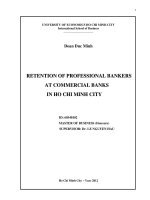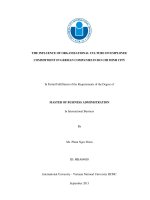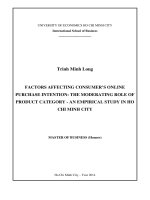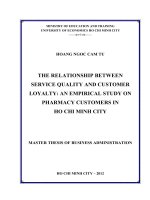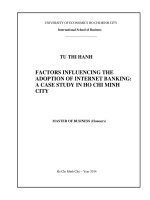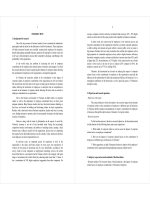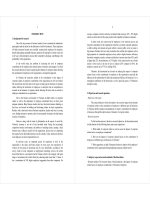The influence of organizational culture on employee commitment in german companies in ho chi minh city
Bạn đang xem bản rút gọn của tài liệu. Xem và tải ngay bản đầy đủ của tài liệu tại đây (2.3 MB, 107 trang )
THE INFLUENCE OF ORGANIZATIONAL CULTURE ON EMPLOYEE
COMMITMENT IN GERMAN COMPANIES IN HO CHI MINH CITY
In Partial Fulfillment of the Requirements of the Degree of
MASTER OF BUSINESS ADMINISTRATION
In International Business
By
Ms. Pham Ngoc Diem
ID: MBA04005
International University - Vietnam National University HCMC
September 2013
THE INFLUENCE OF ORGANIZATIONAL CULTURE ON EMPLOYEE
COMMITMENT IN GERMAN COMPANIES IN HO CHI MINH CITY
In Partial Fulfillment of the Requirements of the Degree of
MASTER OF BUSINESS ADMINISTRATION
In International Business
by
Ms. Pham Ngoc Diem
ID: MBA04005
International University - Vietnam National University HCMC
September 2013
Under the guidance and approval of the committee, and approved by all its members, this
thesis has been accepted in partial fulfillment of the requirements for the degree.
Approved:
---------------------------------------------Chairperson
--------------------------------------------Committee member
---------------------------------------------Committee member
--------------------------------------------Committee member
---------------------------------------------Committee member
--------------------------------------------Committee member
September 2013
Acknowledge
This study would not have been completed without the valuable guidance and the support
of my supervisor, my family and friends. It is my big pleasure to sincerely thank all those
who made this thesis possible.
First of all, I would like to express my sincere gratitude and appreciation to my
supervisor Dr. Phan Trieu Anh for his patient guidance, advices and recommendations for
this research. Thank you for your kind support and encouragement every time when I
have problems ort troubles. You are really a nice and kind advisor that I am honored to be
advised by you.
Secondly, I would like to express my great appreciation to all the teachers of the Master‘s
program in the International University, who imparted their knowledge and experience to
me during the past two years.
To all my family, my friends, and colleagues who supported me in my research, I would
like to give you all my big thanks and appreciation for your time and advices for me.
Thank you.
Last but not least, I would like to thank the Examination Committee members very much
for your time and valuable comments for my thesis‘ improvement.
-i-
Plagiarism Statements
I would like to declare that, apart from the acknowledged references, this thesis
either does not use language, ideas, or other original material from anyone; or has not
been previously submitted to any other educational and research programs or institutions.
I fully understand that any writings in this thesis contradicted to the above statement will
automatically lead to the rejection from the MBA program at the International University
– Vietnam National University Ho Chi Minh City.
- ii -
Copyright Statement
This copy of the thesis has been supplied on condition that anyone who consults
it is understood to recognize that its copyright rests with its author and that no quotation
from the thesis and no information derived from it may be published without the author‘s
prior consent.
© Pham Ngoc Diem/MBA04005/2011-2013
- iii -
Table of Contents
List of Figure ................................................................................................................................. vii
List of Table .................................................................................................................................. viii
Abstract ........................................................................................................................................... ix
INTRODUCTION ......................................................................................................................... 1
1.1.
Background of Research ............................................................................................... 1
1.2.
Problem Statement......................................................................................................... 2
1.3.
Main research question ................................................................................................. 2
1.4.
Objective ......................................................................................................................... 3
1.5.
Implications of the study ............................................................................................... 3
1.6.
Organization of research ............................................................................................... 4
CHAPTER II .................................................................................................................................. 6
LITERATURE REVIEW ............................................................................................................. 6
2.1.
Organizational Culture and Employee Commitment ................................................. 6
2.1.1.
Organizational Culture ................................................................................ 6
2.1.2.
Employee’s commitment ............................................................................ 10
2.1.3.
Organization culture and employee’s commitment .................................. 13
2.2.
German organizational culture................................................................................... 15
2.3.
Results of Empirical Research .................................................................................... 16
2.4.
Conceptual Framework and Research Hypotheses .................................................. 17
2.4.1.
Teamwork ................................................................................................... 18
2.4.2.
Innovation Orientation .............................................................................. 19
2.4.3.
Supportiveness............................................................................................ 20
2.4.4.
Management Style ...................................................................................... 20
2.4.5.
Customer orientation ................................................................................. 21
2.4.6.
Reward and recognition ............................................................................. 22
CHAPTER III .............................................................................................................................. 24
METHODOLOGY ...................................................................................................................... 24
3.1.
Research approach....................................................................................................... 24
3.2.
Sampling Method ......................................................................................................... 25
3.3.
Data collection method ................................................................................................ 26
3.3.1.
Secondary Data .......................................................................................... 26
3.3.2.
Primary Data .............................................................................................. 26
- iv -
3.4.
Sample and Survey Procedures .................................................................................. 27
3.5.
Questionnaire constructs ............................................................................................. 28
3.6.
Variable Measurements............................................................................................... 29
3.6.1.
Independent Variables: Corporate Culture Dimensions .......................... 29
3.6.2.
Dependent Variable: Employees’ Organizational Commitment .............. 30
3.7.
Data Analysis Techniques ........................................................................................... 34
3.7.1.
Descriptive Analysis ................................................................................... 34
3.7.2.
Reliability Analysis ..................................................................................... 34
3.7.3.
Exploratory Factor Analysis (EFA) .......................................................... 34
3.7.4.
Correlation ................................................................................................. 34
3.7.5.
Multiple regressions ................................................................................... 35
3.8.
Limitation of the study ................................................................................................ 35
CHAPTER IV .............................................................................................................................. 36
DATA ANALYSIS AND RESULTS .......................................................................................... 36
4.1.
Sample Description ...................................................................................................... 36
4.2.
Reliability Test ............................................................................................................. 38
4.2.1.
Organizational culture measurement........................................................ 39
4.2.2.
Employee’s commitment measurement ..................................................... 43
4.3.
Validity Test: Exploratory Factor Analysis............................................................... 45
4.3.1.
Factor Analysis for independent variables ............................................... 45
4.3.2.
Factor Analysis for dependent variables ................................................... 48
4.4.
Revised conceptual framework ................................................................................... 49
4.5.
Testing the correlation between Independent Variables and Dependent Variable 51
4.6.
Identifying factors influencing employee’s commitment.......................................... 54
4.7.
Further findings ........................................................................................................... 58
4.7.1.
Difference in Employee’s commitment between age groups .................... 58
4.7.2.
Difference in Employee’s commitment between male and female .......... 58
4.7.3.
Difference in Employee’s commitment between highest qualification .... 60
4.7.4.
Difference in Employee’s commitment between monthly income ........... 60
4.7.5.
Difference in Employee’s commitment between working period ............. 61
4.8.
Summary....................................................................................................................... 62
-v-
CHAPTER V ................................................................................................................................ 64
CONCLUSION AND DISCUSSION ......................................................................................... 64
5.1.
Conclusion .................................................................................................................... 64
5.2.
Contribution and Suggestion for Organization......................................................... 65
5.3.
Limitation of study and Suggestion for further research ......................................... 67
5.3.1.
Limitation of study ..................................................................................... 67
5.3.2.
Suggestion for further researches ............................................................. 68
LIST OF REFERENCES ............................................................................................................ 70
APPENDIX I ................................................................................................................................ 72
APPENDIX II............................................................................................................................... 77
APPENDIX III ............................................................................................................................. 79
APPENDIX IV ............................................................................................................................. 84
APPENDIX V ............................................................................................................................... 94
- vi -
List of Figure
Figure 1: Seven primary characteristics of organizational culture ........................................... 8
Figure 2: Four dimensions of organizational culture ................................................................. 9
Figure 3: The three pillar model of commitment ...................................................................... 10
Figure 4: The three components model of employee’s commitment ....................................... 12
Figure 5: The three factors of organizational commitment ..................................................... 12
Figure 6: Conceptual Framework .............................................................................................. 18
Figure 7: Research design ........................................................................................................... 25
Figure 8: Summary of hypotheses for revised research model ................................................ 51
Figure 9: Result of testing hypotheses for revised research model ......................................... 57
- vii -
List of Table
Table 1: Dimensions of corporate culture.................................................................................... 7
Table 2 Systematization of empirical OC and Employee’s commitment studies ................... 16
Table 3: Summary the structure of questionnaires for official survey ................................... 29
Table 4: Variable Measurements ............................................................................................... 30
Table 5: Descriptive statistics for demographic variables........................................................ 36
Table 6: Reliability with Cronbach alpha for Organizational Culture dimension ................ 41
Table 7: Reliability with Cronbach alpha for Employee’s commitment ................................ 43
Table 8: Reliability with Cronbach alpha for Employee’s commitment - New ..................... 44
Table 9: Factor analysis – Independent indicators - KMO and Bartlett's Test ..................... 46
Table 10: Eigenvalues and Sums of Squared Loadings- Independent indicators .................. 46
Table 11: Factor analysis – Independent indicators – final ..................................................... 47
Table 12: Factor analysis – Dependent indicators - KMO and Bartlett's Test ...................... 48
Table 13: Factor analysis – Dependent indicators - Total Variance Explained ..................... 48
Table 14: Variables after the validity test .................................................................................. 49
Table 15: Correlations ................................................................................................................. 53
Table 16: Adjusted R Square – Hypotheses testing .................................................................. 55
Table 17: ANOVAb – Hypotheses testing .................................................................................. 55
Table 18: Coefficientsa - Hypotheses testing ............................................................................. 56
Table 19: Summary hypotheses testing...................................................................................... 57
Table 20: Test of demographic variable - Age .......................................................................... 58
Table 21: Test of demographic variable - Gender .................................................................... 59
Table 22: Test of demographic variable - highest qualification .............................................. 60
Table 23: Test of demographic variable – Monthly income..................................................... 60
Table 24: Test of demographic variable – Working period ..................................................... 61
- viii -
Abstract
The aim of this study is to examine the influence of organizational culture factors
on employees‘
organizational
commitment.
The
organizational culture
that
investigates in this research was consist of six dimensions which are teamwork
orientation; innovative orientation; supportiveness, reward orientation, management style
and customer orientation within five German organizations in Ho Chi Minh City. In this
regard, the components of organizational culture as the independent variable were
derived from Shim's model and the relationship between two kinds of variables was
tested through Pierson correlation testing. The results from the study showed that there
was a significant relationship between four components of organizational culture
(including teamwork orientation; innovative orientation; reward orientation, and
management style) and employee‘s commitment to organizational culture.
This study contributes to a better understanding of the influence of corporate culture
factors on organizational commitment among employees within five German
organizations in Ho Chi Minh City.
Research methods used to test the hypotheses is quantitative methods with questionnaire
survey and sample size n = 360. Scale was assessed by Cronbach alpha analysis and
exploratory factor analysis (EFA) to examine the reliability and validity.
The author also has some suggestions for future study of related topic.
Keywords: organizational culture, organizational commitment, employee‘s
commitment
- ix -
CHAPTER I
INTRODUCTION
This chapter will basically introduce what the author intend to do in this research. The
overview of the thesis includes the background of the study, the problem statement,
research question, research objectives and limitation to the study.
1.1.
Background of Research
Corporate culture has been ―an important theme in management and business research
for the past few decades due to its potential to affect a range of organizationally and
individually desired outcomes such as commitment, loyalty, turnover intent, and
satisfaction‖ (Chow et al., 2001). The importance of corporate culture is stressed by
Peters and Waterman (1999:808) that "Without exception, the dominance and
coherence of culture proved to be an essential quality of the excellent company.
Moreover the stronger the culture, the more it was directed to the marketplace, the less
need was there for policy manuals, organization charts, detailed procedures or rules.
In these companies, people way down the line knows what they are supposed to do in
most situations because the handful of guiding values is crystal clear‖.
There has been a significant change in the awareness of board of company‘s
management about their employees. A survey conducted by CareerBuilder – a leading
job ‗seeking website in the world (the weekend Doanh Nhan Saigon newspaper on
10th Jan, 2008) has indicated the growing dissatisfaction among the employees that
out of every four people has one person is bored with his job, and the number of such
discouragement increased an average of 20% in the following 2 years. With 6 out of
10 respondents are intending leave your current job. Thus, solving the problem of
human resources is not an easy task for organizations nowadays.
1
The main aim of the HR management is to manage human resources efficiency, which
reduces employee turnover (Rijamampianina, 2001). For that purpose, managers need
to understand what employees are looking for at work. In other words, managers need
to understand their employees feeling about their work to enhance their commitment
with the company.
There are many aspects of the company influencing the employee‘s commitment.
However, the organizational culture is one of the most important aspects, sometimes
the employee cares much more about the organizational culture than other aspects in
the company.
Therefore, in this study, the author will mention these aspects of the organizational
cultures which involve in the employee‘s commitment with the companies.
1.2.
Problem Statement
In Ho Chi Minh City, there are many foreign companies with different corporate
culture which are strongly attracting young and highly qualified workforce.
However, the commitment of the staffs is also problematic with these foreign
enterprises. The flow of staffs between foreign firms is relatively large at the moment.
There are many aspects affecting the employee‘s commitment to companies. So, the
question is whether organizational culture factors in the foreign companies, especially
in German companies, have anything affects the commitment of the employees.
Within the scope of this thesis, the author will research the factors of organizational
cultures which influence on the employees‘ commitment in 5 German companies in
Ho Chi Minh City.
1.3.
Main research question
To achieve the above objectives, the author needs to find the answer of the following
questions:
2
-
Which factors of the organizational culture directly influence the
employee‘s commitment?
-
What are the strengths of organizational culture‘s factors in influencing the
employee commitment?
1.4.
Objective
The main aim of this study is:
-
To study
the
relationship
between
organizational
culture
and
organizational commitment of employees
-
To help the organization have deep understanding of their employee‘s
commitment.
-
To provide suggestions for organizational culture to enhance organizational
commitment of employees
1.5.
Implications of the study
Organizational culture has a significant variety among the firms. The relationship
between the employees' job performance and their commitment also varied
significantly with organizational culture values. Every organization has set of
principles and policies mandatory for all the employees to follow. If those policies are
so different from what exists in Vietnam for a long time, the employees will feel
uncomfortable and unacceptable with such a strange culture. That‘s also the reason
why the staff‘s commitment is short.
In some previous study of some experts, they also consider the role of organizational
culture on the employee‘s commitment. Sheridan (1992) in his research observes that
organizational culture was significantly related to performance and voluntary
turnover.
3
Therefore, this research is to examine the relationship between the organizational
culture and the commitment with the companies of the employees. So, the research
will help the companies to find out which aspects of their culture are positive or
negative to the employee‘s commitment. Also, the Vietnamese staffs also have a deep
knowledge about their companies‘ culture to understand and adapt in long term
period.
1.6.
Organization of research
This thesis is divided into five chapters:
-
Chapter 1: Introduction
This chapter presents an overview of the study, the problem statement,
research objectives and limitations to the study.
-
Chapter 2: Literature review
This chapter examines literature about organizational culture. The literature
reviewed starts by defining organizational culture, and then goes on to discuss
how culture is created and sustained in an organization. This chapter also looks
at other research studies on organizational culture. Then, this chapter reviews
literature on employee commitment and its importance to an organization. The
ways of maintaining and sustaining employee commitment as well as research
initiatives on the subject of employee commitment are also discussed.
-
Chapter 3: Research methodology to test the hypotheses proposed.
This chapter shows how the research was conducted. It provides insight into
the sampling method used, data collection techniques, research design, variable
measurements, questionnaire construction.
4
-
Chapter 4: Analysis and research results.
This chapter presents the way of analyzing the data after being collected and
he tools to test that raw data set. The research results also are analyzed here to
evaluate the relation of organizational culture and employee‘s commitment.
-
Chapter 5: Conclusion and discussion
Summary of the main results of the study, contributions of the research
implications for organization management as well as the limitations of the
present study and suggestions for further research in the future research.
5
CHAPTER II
LITERATURE REVIEW
Chapter one has briefed the objectives and meaning of the study regards to the
relationship between corporate culture and employee‘s commitment. The purpose of
this chapter is to present the issues in theory and previous related research in the
world. On this basis, the author will develop the research model and hypotheses. This
chapter consists of three main parts: (1) The concept of corporate culture, (2) The
notion of employee‘s commitment to the organization, (3) the relationship between
corporate culture and employee‘s commitment to the organization.
2.1.
Organizational Culture and Employee Commitment
2.1.1. Organizational Culture
Organizational culture has no single definition. However, after the author referred
some trustful sources, there are some of the definitions listed below:
-
A set of common understandings around which action is organized
finding expression in language whose nuances are peculiar to the group
(Becker and Geer, 1960).
-
A set of understandings or meanings shared by a group of people that
are largely tacit among members and are clearly relevant and distinctive to the
particular group which are also passed on to new members (Louis 1980).
-
A system of knowledge, of standards for perceiving, believing,
evaluating and acting, etc. that serve to relate human communities to their
environmental settings (Allaire and Firsirotu, 1984).
In previous study, there seems to be a general understanding regarding the
corporate culture values and activities that contribute to the development of
―business excellence.‖ Recardo and Jolly (1997) have identified eight established
6
dimensions of corporate culture: communication, training and development, rewards,
effective decision making, risk-taking for creativity and innovation, proactive
planning, teamwork, and fairness and consistency in management practices.
Table 1: Dimensions of corporate culture
Corporate
culture
communication
training and development
rewards
effective decision making
risk-taking for creativity and innovation
proactive planning
teamwork
fairness and consistency in management practices
Source: Recardo and Jolly (1997)
Collins and Porras (2000:338) state that organizational culture refers to a system of
shared meaning held by members that distinguish one organization from other
organizations. They believe that these shared meanings are a set of key characteristics,
and that the organization values and the essence of an organizations culture can be
captured in seven primary characteristics. These characteristics are:
-
Innovation and risk - taking. The degree to which employees are
encouraged to be innovative and take risks;
-
Attention to detail. The degree to which employees are expected to
exhibit precision analysis and attention to detail;
-
Outcome orientation. The degree to which management focuses on
results or outcomes rather than on the techniques and processes used to
achieve those outcomes;
7
-
People orientation. The degree to which management decisions take
into consideration the effect of outcomes on people within the
organization;
-
Team orientation. The degree to which work activities are organized
around teams rather than individuals;
-
Aggressiveness. The degree to which people are aggressive and
competitive rather than easygoing; and
-
Stability. The degree to which organizational activities emphasize
maintaining the status quo in contrast to growth.
Innovative
Detail
Oriented
Aggressive
Organization
Culture
Profile
Team
Oriented
Outcome
Oriented
People
Oriented
Stable
Figure 1: Seven primary characteristics of organizational culture
Source: Collins and Porras (2000:338)
In speaking of dimensions of organizational culture, Huijser (2006) also built up a
model of corporate culture including four dimensions which all national and
organizational cultures can be categorized. All cultures fit into one or more of the
following orientations: Action, Process, Task and Role. This corporate culture scan
follows the Model of Freedom, inspired by the work of Kolb (learning styles) and
8
Leary (Rose of Leary, behavior and influencing). In this structure, each dimension is
respected by one element such as Leading Behavior for Action factor, People Oriented
for Role, Following Behavior for Process and Task Oriented for task.
LEADING BEHAVIOR
Competitive
Aggressive
Direct
ACTION
TASK
“I disagree”
Rebellious
Accusing
Withdraw
n
Leading
Supportive
Engaging
“We will”
PEOPLE ORIENTED
TASK ORIENTED
“I can do”
ROLE
PROCESS
Compliant
Dependent
Avoiding
“Tell us”
FOLLOWING
BEHAVIOR
Figure 2: Four dimensions of organizational culture
Source: Huijser (2006)
Conclusion
In the previous studies, corporate culture are defined and measured by many different
factors. Each researcher has his own reasons to take out their own corporate culture
measuring. However, within the scope of this paper, the author will focus on selection
which factors matched the culture of German companies. German organizational
culture has some typical characteristics compared with other foreign companies.
9
2.1.2. Employee’s commitment
The issue of organizational commitment is very important for managers in
organization (Tushman and O‘Reilly (1997); Nadler, 1997).; and Limerick, et
al., 1998), either government organization or private sector. In order to increase
their competitive advantage, the managers always seek ways to enhance their
employee‘s commitment. They are more concern to find strategic way that has
a big influence toward commitment. Organizational commitment refers to an
employee‘s belief in the organization‘s goals and values, desire to remain a
member of the organization and loyalty to the organization Mowday, et al., 1982; and
Hackett, et al, 2001). This definition, reflecting an individual‘s affective commitment,
represents a major approach to the study of organizational commitment (Meyer et al.,
2002 in Boon and Arumugam, 2006), and appears to be the most desired form of
commitment.
A sense of belonging to the organization
A sense of excitement in the job
Confidence in management
Figure 3: The three pillar model of commitment
(Source: Mullins, 1999:813)
Based on case studies that focused on employee commitment of fourteen British
organizations, including Jaguar, Royal Bank of Scotland, British Steel, Pilkington‘s,
Rothmans, Raleigh, and Schweppes, Martins and Nicholls (in Mullins, 1999:813)
formulated a model of commitment based on three major pillars, as shown in Figure 3.
These pillars are:
10
-
A sense of belonging to the organization: This builds upon the loyalty essential
to successful industrial relations. The sense of belonging is created by
managers through ensuring the workforce is informed, involved and sharing in
success.
-
A sense of excitement in the job: Improved results will not be achieved unless
workers can also feel a sense of excitement about their work which results in
the motivation to perform well. This sense of excitement can be achieved by
appealing to the higher-level needs of pride, trust and accountability for
results.
-
Confidence in management: The senses of belonging and excitement can be
frustrated if workers do not have respect for, and confidence in, management
leadership. This respect is enhanced through attention to authority, dedication
and competence. A large measure of the success of the organizations studied
derives from their management of people and from creating a climate for
commitment. For example, if people feel trusted, they will make extraordinary
efforts to show the trust to be warranted. However, creating commitment is
hard. It takes time, the path is not always smooth and it requires dedicated
managers (Mullins, 1999:813).
Meyer and Allen (1991) in Parish, et al., (2008), have proposed model
comprising affective, continuance, and normative commitment. According to
Meyer and Allen (1991) in Parish, et al., (2008), affective commitment (AC)
―refers to the employee‘s emotional attachment to, identification with,
and involvement in the organization‖ (employees stay with a firm because
they want to); continuance commitment (CC) ―refers to an awareness of the
costs associated with leaving the organization‖ (employees stay with a firm
11
because they need to); and normative commitment ―reflects a feeling of
obligation to continue employment‖ (employees stay with a firm because they
ought to).
continuance
commitment
(CC)
affective
commitment
(AC)
normative
commitment
(NC)
Figure 4: The three components model of employee’s commitment
Source: Meyer and Allen (1991) in Parish, et al., (2008)
Based on attitudinal commitment, Mowday et al. (1979) define organizational
commitment as the relative strength of an individual‘s identification with, and
involvement in a particular organization. This can be characterized by three related
factors: a strong belief in and acceptance of the organization‘s goals and values; a
willingness to exert considerable effort on behalf of the organization; and a strong
desire to maintain membership in the organization.
a strong belief in and acceptance of the
organization‘s goals and values
a willingness to exert considerable effort
on behalf of the organization
a strong desire to maintain membership in
the organization
Figure 5: The three factors of organizational commitment
12
Source: Mowday et al. (1979)
Conclusion
Most of previous studies deeply focused each factor measuring the employee's
commitment to the organization. Each study has its meaning and suitability for each
company. In this essay, author refers and concludes that the employees in German
companies are not following to any specific model. Therefore, the author carefully
chooses which factors can be used in this research for independent variables. The
author much focuses on the general definition of employee‘s commitment.
2.1.3. Organization culture and employee’s commitment
Some writers have insisted that other group culture could stand alone of the
organizational culture, and a small working team might have its own particular set of
values, beliefs and attributes (Brown, 1995, Martin 1992, Martin and Siehl, 1983,
Schneider, 1990; Sackman 1991; Trice and Beyer, 1993). Brewers (1993) stated that if
an organization's culture is not strong enough, the group culture may be prioritized
over organizational culture for employees and therefore gain their commitment (Lok
and Crawford, 1999). So, it is the intention of the study is to investigate the
relationship of organizational culture with the commitment.
As a result of the importance of organizational commitment, several studies (Allen
and Meyer, 1990; Chen et al., 2006; Clugston, 2000; DeCottis and Summers, 1987;
Iverson and Roy, 1994; Lok and Crawford, 2001; Khan et al., 2011; Michaels, 1994;
Salami, 2008; Steinhaus and Perry; Taormina, 1999) have sought to identify its causal
antecedents. However, corporate culture has received relatively low levels of
empirical investigation among the possible antecedents of organizational commitment
(Lok and Crawford, 2004). The authors (Lok and Crawford) expressed their surprise
that corporate culture was not mentioned in Mathieu and Zajac‘s (1990)
13
comprehensive meta-analysis and review of the antecedents and correlates of
organizational commitment.
Although empirical research has been carried out on corporate culture and employee
commitment to the organization, there has been little evidence to prove the effect of
corporate culture on organizational commitment (McKinon et al., 2003). In a study of
Hong Kong and Australian managers, Lok and Crawford (2004) found a positive
effect of corporate culture on organizational commitment. Zain et al. (2009) examined
the effect of four dimensions of corporate culture namely teamwork, communication,
reward and recognition, and training and development on organizational commitment
and found that all the four dimensions of corporate culture were important
determinants of organizational commitment. While Mahmudah (2012) report a
significant relationship between corporate culture and organizational commitment,
research by Lahiry (1994) showed only a weak association between corporate culture
and organizational commitment. This study seeks to further examine this relationship
with particular reference to the Nigerian work environment
Regard to the relationship between organizational culture and the employees
commitment, other scholars focus on cultural dimensions, such as stability (a culture
emphasizing the importance of reducing uncertainty at work) and attention to detail (a
culture focusing on the detail of practices). Scholars such as Chuang, et al. (2004);
O'Reilly III, et al. (1991); Shim (2010) found a strong link between these dimensions
and employees‘ voluntary turnover and concluded that organizations can utilize such
elements to retain their employees. O‘Reilly, et al. (1991) has identified five main
organizational culture-related factors relevant to the dimensions of corporate culture:
-
Teamwork orientation,
-
Innovation orientation,
14

